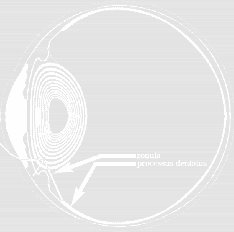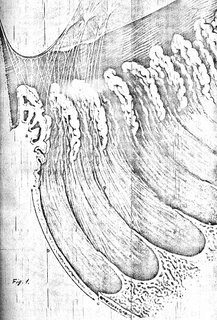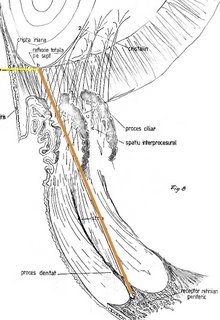by Dr Dan Waniek, MD
Copyright © 2006 danwaniek.org
The meaning of such differential stimulation of the processi dentati, according to an irido-morphologic code, could be to provide optical information to the cortex - with the purpose of producing specific signals of homeostatic value to targets within the body.
Should this model be true, a coherent possibility for a new homeostatic circle arises :
( a ) A deficient structure within the body might induce changes in iridial morphology
or...
( a' ) deficiencies might be expressed in the morphogenesis of the iris of the same phenotype.
( b ) The iris codes the light signal and transmits it to the ora serrata;
( c ) The ora serrata informs the cortex, acting like a peripheral sensitive homunculus,
(c') possibly via the lateral geniculate body and the pulvinar of the thalamus...
( c'' ) because of their strategic position in the diencephalon;
( d ) The cortex produces homeostatic messages ( nerve impulses or chemical mediators )...
( d' ) to compensate for the deficiency...
( d'' ) possibly by converting normal into “ exceptional ” metabolic pathways.
Understanding the Iris :
Non-visual functions of the Eye.
Trans-Iridial Studies Updates :
An Electronic Magazine
ISSN 1297-9953
Tuesday, April 11, 2006
Opus Princeps of Trans-Iridial Studies : Model
by Dr Dan Waniek, MD
Copyright © 2006 danwaniek.org
This anatomical entity could be a functional unit for non-visual processing of light information. It would provide homeostatic messages to the brain, not in the form of images, by physiological mechanisms that are still to be discovered.

Fig. 5 : Pathways of Light in Sagittal Sections of the Anterior Pole.
The optical information is hypothetically coded by the radial transparency pattern of the iris in terms of intensity, position and specific local absorption of the transmitted light, and is received by the corresponding dentate process.
Copyright © 2006 danwaniek.org
This anatomical entity could be a functional unit for non-visual processing of light information. It would provide homeostatic messages to the brain, not in the form of images, by physiological mechanisms that are still to be discovered.

Fig. 5 : Pathways of Light in Sagittal Sections of the Anterior Pole.
The optical information is hypothetically coded by the radial transparency pattern of the iris in terms of intensity, position and specific local absorption of the transmitted light, and is received by the corresponding dentate process.
Opus Princeps of Trans-Iridial Studies : More Data
by Dr Dan Waniek, MD
Copyright © 2006 danwaniek.org
The observation has been confirmed by many recent photographs taken from the interior of the eyeball, including this original indeed historical one :

Fig : 4 : High resolution intra-ocular photograph taken in vivo, from behind the lens and towards the anterior pole. Courtesy of Paris Match © Lennart Nilssen, 1985, by kind permission.
Copyright © 2006 danwaniek.org
The observation has been confirmed by many recent photographs taken from the interior of the eyeball, including this original indeed historical one :

Fig : 4 : High resolution intra-ocular photograph taken in vivo, from behind the lens and towards the anterior pole. Courtesy of Paris Match © Lennart Nilssen, 1985, by kind permission.
Wednesday, April 05, 2006
Opus Princeps of Trans-Iridial Studies : Data
by Dr Dan Waniek, MD
Copyright © 2006 danwaniek.org
We report here a simple observation to support our functional model : a spatial correspondence between :
(a) radial transparencies in iridial structure,
(b) circular sectors in iridological charts,
(c) inter-processural spaces ( the ciliary valleys ) and
(d) processi dentati,
does indeed exist ( Fig. 3 ).

Fig. 3 : A novel observation concerning the anterior pole's peripherally aligned ( APPA ) vertebrate ocular structures : The spatial correspondence between the radial ( meridional ) structural elements of the iris, the lens and the peripheral retina, as they are viewed from the interior of the eye ( left ) and in medio-sagittal section ( right ) is put into evidence and more diagrammatically shown. There are radial transparencies ( 1 ) and stromal crypts ( 2 ) in the stroma of the iris, and these structures are in a good alignment with the ciliary valleys ( the free space between two adjacent processi ciliares ( 3 ) in pars plicata ). This alignment is shown further in pars plana, where the dentate processi of the retina ( 4 ) protrude along the symmetry axes provided by the striae ( which are not shown ). Light is permitted to reach the processi dentati along this path, considering that total reflection takes place on the anterior surface of the lens and its inter-strata. Only the inferior half of the lens is figured in the left panel. The dots at left stress the repetitive functional unit described here.
Copyright © 1986-2006 danwaniek.org ( Digimarc creator ID 10-727074 ) and the Iris-Ward.com, Inc. Based on an illustration originally published by Churchill Livingstone, with permission. All Rights Reserved.
Copyright © 2006 danwaniek.org
We report here a simple observation to support our functional model : a spatial correspondence between :
(a) radial transparencies in iridial structure,
(b) circular sectors in iridological charts,
(c) inter-processural spaces ( the ciliary valleys ) and
(d) processi dentati,
does indeed exist ( Fig. 3 ).

Fig. 3 : A novel observation concerning the anterior pole's peripherally aligned ( APPA ) vertebrate ocular structures : The spatial correspondence between the radial ( meridional ) structural elements of the iris, the lens and the peripheral retina, as they are viewed from the interior of the eye ( left ) and in medio-sagittal section ( right ) is put into evidence and more diagrammatically shown. There are radial transparencies ( 1 ) and stromal crypts ( 2 ) in the stroma of the iris, and these structures are in a good alignment with the ciliary valleys ( the free space between two adjacent processi ciliares ( 3 ) in pars plicata ). This alignment is shown further in pars plana, where the dentate processi of the retina ( 4 ) protrude along the symmetry axes provided by the striae ( which are not shown ). Light is permitted to reach the processi dentati along this path, considering that total reflection takes place on the anterior surface of the lens and its inter-strata. Only the inferior half of the lens is figured in the left panel. The dots at left stress the repetitive functional unit described here.
Copyright © 1986-2006 danwaniek.org ( Digimarc creator ID 10-727074 ) and the Iris-Ward.com, Inc. Based on an illustration originally published by Churchill Livingstone, with permission. All Rights Reserved.
Opus Princeps of Trans-Iridial Studies : Hypotheses
by Dr Dan Waniek, MD
Copyright © 2006 danwaniek.org
We have hypothesized that the iris may be able to transmit light through its stroma in spite of the irregularly dispersed, heavily absorptive pigment. This transmitted light, without interfering with the centro-retinal image because of total reflection on the anterior surface of the lens is, however, significant, and acts as a coded non-visual stimulus for the periphery of the retina.
The peripheral retina consists of a highly regular array of about seventy protrusions of nervous tissue, the processi dentati, in the pars plana of the ciliary body, collectively named the ora serrata.

This structure has not been understood so far in terms of vision : Indeed, campimetry fails to demonstrate correspondent protrusions in the margins of the visual field, even if there is positive histological evidence of normal receptive retinal structure in the ora serrata, to account for visual perception.
In our model the ora serrata is assumed to have a previously undescribed non-visual function. A critical test of these hypotheses would be to determine whether electro-retinography (ERG) can detect specific activity in the ora serrata when the surface of the iris, and not the pupil is light-stimulated.
This study was undertaken because of controversy existing between the conclusions of different approaches concerning the evaluation of iridology, the controversial diagnostic method based on clinical and empirical studies of the iridial morphology.
Copyright © 2006 danwaniek.org
We have hypothesized that the iris may be able to transmit light through its stroma in spite of the irregularly dispersed, heavily absorptive pigment. This transmitted light, without interfering with the centro-retinal image because of total reflection on the anterior surface of the lens is, however, significant, and acts as a coded non-visual stimulus for the periphery of the retina.
The peripheral retina consists of a highly regular array of about seventy protrusions of nervous tissue, the processi dentati, in the pars plana of the ciliary body, collectively named the ora serrata.

This structure has not been understood so far in terms of vision : Indeed, campimetry fails to demonstrate correspondent protrusions in the margins of the visual field, even if there is positive histological evidence of normal receptive retinal structure in the ora serrata, to account for visual perception.
In our model the ora serrata is assumed to have a previously undescribed non-visual function. A critical test of these hypotheses would be to determine whether electro-retinography (ERG) can detect specific activity in the ora serrata when the surface of the iris, and not the pupil is light-stimulated.
This study was undertaken because of controversy existing between the conclusions of different approaches concerning the evaluation of iridology, the controversial diagnostic method based on clinical and empirical studies of the iridial morphology.
Opus Princeps of Trans-Iridial Studies : Introduction
by Dr Dan Waniek, MD
Copyright © 2006 danwaniek.org
The obvious function of the iris is to provide an optical diaphragm for the system that produces images on the central part of the retina.

Interestingly, the morphology of the iridial stroma and epithelia seem to support more than the necessities of a highly aperture-adjustable structure. Its crypts and chromatic accidents offer a variable and complicated pattern of densities and transparencies that have stimulated several studies, both scientific and empirical.

Copyright © 2006 danwaniek.org
The obvious function of the iris is to provide an optical diaphragm for the system that produces images on the central part of the retina.

Interestingly, the morphology of the iridial stroma and epithelia seem to support more than the necessities of a highly aperture-adjustable structure. Its crypts and chromatic accidents offer a variable and complicated pattern of densities and transparencies that have stimulated several studies, both scientific and empirical.

Subscribe to:
Comments (Atom)